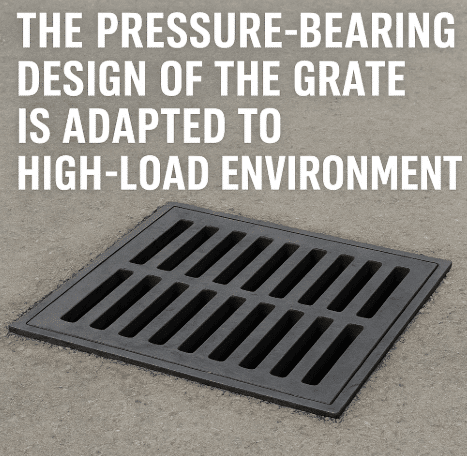In modern infrastructure, grates are more than simple covers over drainage channels—they are essential safety components engineered to handle heavy loads, ensure drainage efficiency, and maintain long-term durability. Whether used on urban roads, airports, industrial parks, or logistics centers, the grate pressure-bearing design directly influences performance, safety, and service life.
High-load environments require advanced structural design and superior materials. Understanding how these grates are engineered helps planners, engineers, and buyers select the right product for each application.
Understanding the Concept of Pressure-Bearing Design
What Is a Pressure-Bearing Grate?
A pressure-bearing grate is a structural element designed to withstand vertical and horizontal forces generated by passing vehicles, pedestrians, or machinery. Its load-bearing capacity depends on material composition, rib structure, frame reinforcement, and installation method.
For example, a drainage grate used on a highway must resist the repetitive stress of heavy trucks while maintaining its shape and position. The design must prevent deformation, noise, or failure even under extreme pressure conditions.
Key Principles of Load Distribution
To achieve excellent performance in high-load environments, engineers follow several fundamental principles:
- Uniform Load Distribution: The grate should evenly distribute pressure across its surface, reducing localized stress.
- Reinforced Frame Design: A robust frame prevents displacement and adds stability.
- Material Strength: Materials such as ductile iron, stainless steel, or composite resin are chosen based on required strength and corrosion resistance.
- Structural Geometry: Grids, ribs, and honeycomb patterns enhance rigidity and reduce deformation.
Types of Grates Used in High-Load Environments
Ductile Iron Grates
Ductile iron grates are among the most widely used solutions for heavy-load drainage systems. Their graphite microstructure provides excellent strength and flexibility, allowing them to handle high mechanical stress.
- Ideal for: roads, bridges, ports, and logistics hubs
- Benefits: corrosion-resistant, anti-slip surface, high tensile strength
Steel Grating Systems
Steel grates are preferred in industrial and manufacturing areas. They combine high-pressure resistance with precise dimensions, often featuring anti-rust coatings or galvanization.
- Ideal for: factories, chemical plants, and airports
- Benefits: strong rigidity, customizable load rating, easy installation
Composite Grates
In recent years, composite materials have gained popularity for their lightweight and non-corrosive nature. Although lighter, advanced fiber-reinforced polymer composites can still reach impressive load-bearing capacity while offering a longer lifespan.
- Ideal for: coastal regions, public walkways, and parks
- Benefits: rust-free, lightweight, customizable appearance
Engineering Design Considerations for High-Load Environments
Structural Optimization
The grate pressure-bearing design must be adjusted according to environmental and usage factors. Engineers analyze:
- Load frequency and maximum vehicle weight
- Drainage efficiency requirements
- Expected environmental exposure (moisture, chemicals, salt)
Finite element analysis (FEA) is often used to simulate load distribution, ensuring the grating system meets safety and performance standards.
Material Selection and Standards
Different international standards (EN 124, AASHTO, ISO 1083) define load classes such as:
- Class D400 – heavy-duty roads and truck routes
- Class E600 – industrial docks and airports
- Class F900 – high-pressure zones such as aircraft runways
Proper selection ensures the drainage grate performs safely without overengineering costs.
Anti-Slip and Safety Features
In high-load environments, safety is as important as strength.
Anti-slip surface textures, secure locking mechanisms, and rubber sealing prevent movement or vibration, especially under high traffic or mechanical loads.
Case Studies of Grate Design in Real Projects
Airport Runway Drainage System
Airports demand extreme performance from their heavy-duty grating systems. The design must endure the impact of aircraft tires weighing several tons. Ductile iron grates reinforced with double ribs are commonly used, featuring high ductility and elasticity to absorb pressure.
Urban Highway Drainage
In high-traffic areas, pressure-bearing grates are designed to integrate seamlessly with asphalt or concrete pavement. These systems not only support continuous heavy loads but also facilitate quick water drainage to prevent flooding.
Industrial Factory Floor
Factories and warehouses often experience vibration and mechanical loads from forklifts and cranes. Custom grate pressure-bearing designs in stainless steel ensure durability and prevent deformation even under dynamic impact loads.
Maintenance and Lifecycle Management
Routine Inspection and Cleaning
Regular maintenance is vital for ensuring long-term load-bearing performance.
- Inspect bolts, frames, and surface deformation
- Remove debris to maintain drainage efficiency
- Replace damaged or corroded grates promptly
Extended Service Life Through Design
By using anti-corrosion coatings and precision manufacturing, the grate pressure-bearing design can achieve a service life of over 20 years in demanding environments. Manufacturers often provide custom engineering support to match exact load conditions and design preferences.
The Future of Grate Design
Smart Monitoring and Innovation
With the advancement of smart city infrastructure, new grates are being integrated with sensors that monitor deformation, pressure, and water levels in real time. This helps maintenance teams react quickly to avoid system failures.
Sustainable Materials
Eco-friendly materials such as recycled composites and stainless steel alloys reduce environmental impact while maintaining high-load resistance. Sustainability is becoming a key factor in grate manufacturing innovation.
Conclusion
The pressure-bearing design of grates is the foundation of safe and efficient drainage systems in heavy-load environments. From highways and airports to industrial plants, choosing the right material and structural design ensures long-term performance and safety.
By understanding grate load-bearing principles, engineers and planners can make informed decisions, balancing cost, durability, and environmental impact.
FAQ
Q1: What is the main factor that determines a grate’s load-bearing capacity?
A: The material composition and structural geometry (such as rib thickness and frame support) determine how much pressure a grate can safely handle.
Q2: Which material is best for heavy-load environments?
A: Ductile iron is often the best option for extreme pressure conditions, while stainless steel and composite grates suit environments that require corrosion resistance and aesthetics.
Q3: How can I ensure long-term durability of my drainage grates?
A: Regular maintenance, proper installation, and selecting products compliant with international load standards (EN 124, A15–F900) ensure safety and performance.
Q4: Are customized designs necessary for industrial projects?
A: Yes, customized grate pressure-bearing designs can optimize strength, weight, and drainage efficiency according to specific project requirements.
Q5: How does modern technology improve grate performance?
A: Smart sensors, anti-slip patterns, and advanced manufacturing methods such as CNC machining enhance both functionality and longevity.





